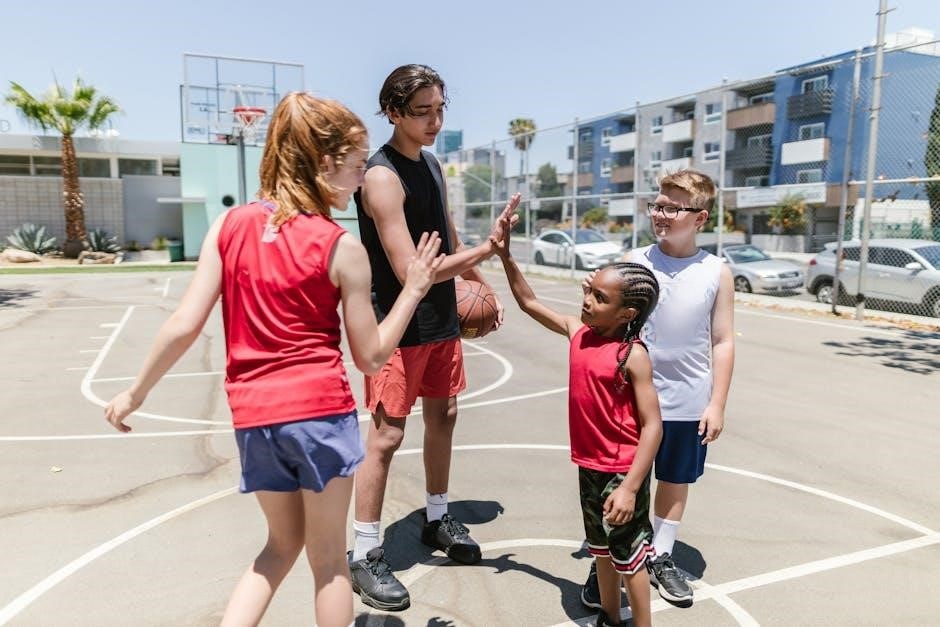A well-structured basketball weight training program is essential for improving performance, preventing injuries, and achieving athletic goals. It combines strength, conditioning, and recovery strategies tailored to different phases of the season.
Overview of Basketball Weight Training
Basketball weight training is a structured approach to enhance strength, endurance, and explosiveness, tailored to the demands of the sport. It involves a combination of strength cycles, plyometric exercises, and conditioning drills to improve power, speed, and agility. Programs are typically divided into phases, such as off-season, pre-season, and in-season training, each with specific goals. For example, off-season focuses on building foundational strength, while in-season maintains performance and prevents fatigue. Additionally, injury prevention is a key component, with exercises targeting common problem areas like knees and shoulders. Proper nutrition and recovery strategies are also integrated to support muscle growth and overall athletic development. A well-designed basketball weight training program ensures players are physically prepared to excel on the court while minimizing the risk of injury. Personalization and periodization are crucial for maximizing results and achieving long-term success.
Importance of Strength and Conditioning in Basketball
Strength and conditioning are vital for basketball players to excel in a physically demanding sport. These elements enhance muscular endurance, explosiveness, and agility, allowing players to perform high-intensity movements like sprints, jumps, and rapid direction changes. Stronger muscles improve power, enabling players to dunk, block shots, and outmaneuver opponents. Conditioning ensures sustained energy levels throughout the game, reducing fatigue and maintaining performance consistency. Additionally, strength training helps prevent injuries by stabilizing joints and building resilience. A well-conditioned player can recover faster between plays and games, giving them a competitive edge. Without adequate strength and conditioning, athletes risk underperformance and increased injury susceptibility. Thus, integrating these components into a basketball weight training program is essential for optimal performance and long-term success in the sport.

Phases of Basketball Weight Training
Basketball weight training is divided into distinct phases: off-season, pre-season, and in-season. Each phase focuses on building strength, enhancing power, and maintaining performance to meet seasonal demands effectively.
Off-Season Training Focus
The off-season is a critical period for basketball players to build foundational strength, increases muscle mass, and improve overall athleticism. During this phase, the focus shifts from sport-specific skills to developing power, endurance, and flexibility. Workouts typically involve high-intensity strength training, such as squats, deadlifts, and bench presses, to target major muscle groups. Additionally, plyometric exercises like box jumps and broad jumps are incorporated to enhance explosiveness. Conditioning drills, including sprint intervals and agility ladder work, are also emphasized to improve speed and lateral movement. The goal is to create a strong physical base that can be refined during the pre-season, ensuring players are prepared for the demands of the upcoming basketball season.
Pre-Season Training Intensity
Pre-season training is characterized by increased intensity and specificity to prepare players for the upcoming basketball season. Workouts focus on enhancing explosive power, speed, and agility while maintaining the strength built during the off-season. High-intensity interval training (HIIT) is commonly used to simulate game-like conditions, improving cardiovascular endurance and muscular stamina. Dynamic movements, such as lateral drills and cone exercises, are emphasized to refine quick changes of direction. Plyometric exercises like burpees and jump squats are integrated to boost explosiveness. Additionally, sport-specific movements, such as jump shots and defensive shuffles, are incorporated to bridge the gap between strength training and on-court performance. This phase ensures players are physically and mentally prepared for the competitive demands of the season.
In-Season Maintenance Strategies
In-season training focuses on maintaining strength, endurance, and explosiveness without overtaxing the body. Workouts are less intense than off-season programs, prioritizing recovery and injury prevention. Players typically follow a 2-day per week weight training schedule, focusing on compound movements like squats, lunges, and bench presses to preserve muscle mass. Conditioning drills are tailored to mimic game scenarios, ensuring cardiovascular fitness remains optimal. Plyometric exercises, such as box jumps and burpees, are incorporated to maintain explosiveness. Recovery strategies, including stretching, foam rolling, and hydration, are emphasized to support continuous performance. The goal is to sustain athletic gains while avoiding fatigue, ensuring players remain competitive throughout the season.

Key Components of a Basketball Weight Training Program
A basketball weight training program includes foundational strength exercises, plyometric training for explosiveness, and conditioning drills for endurance. These elements enhance performance and prevent injuries.
Foundational Strength Exercises
Foundational strength exercises are the cornerstone of any effective basketball weight training program. These exercises focus on building overall muscle strength, stability, and endurance, which are essential for basketball performance. Key exercises include squats, deadlifts, bench presses, and pull-ups, targeting major muscle groups like the legs, core, and upper body. These movements improve power, explosiveness, and durability, reducing the risk of injuries. Additionally, exercises like lunges and step-ups enhance balance and stability, crucial for quick lateral movements on the court. Proper form and progression are emphasized to ensure safety and effectiveness. A well-structured program integrates these exercises with periodization, allowing athletes to build strength progressively throughout the season. This approach ensures players maintain peak performance while adapting to the demands of the game.
Plyometric and Explosive Training
Plyometric and explosive training are crucial for basketball players to enhance vertical leap, acceleration, and overall court performance. These exercises focus on generating maximum force in minimal time, improving power and explosiveness. Key plyometric exercises include box jumps, broad jumps, and depth jumps, which target the lower body’s fast-twitch muscle fibers. Explosive workouts like medicine ball throws and weighted jumps further amplify power output. Incorporating these drills into a training program helps players excel in high-intensity movements, such as dunking, rebounding, and quick changes of direction. Proper progression and recovery are emphasized to prevent overtraining and ensure optimal results. By integrating plyometrics, athletes can achieve significant improvements in speed, agility, and jumping ability, giving them a competitive edge on the court.
Conditioning Drills for Endurance
Conditioning drills are vital for basketball players to build cardiovascular endurance, stamina, and mental toughness. These exercises simulate the high-intensity, stop-and-go nature of the game, improving speed, agility, and overall durability. Popular drills include lateral skips, tuck jumps, and broad jumps, which enhance quick bursts of energy and lateral movement. High-intensity interval training (HIIT) is also widely used, combining sprints and recovery periods to mimic game scenarios. Additionally, exercises like hang snatches and box jumps improve explosive endurance. Proper progression and recovery are essential to avoid overtraining. These drills ensure players can sustain peak performance throughout the game, making them indispensable in a comprehensive basketball weight training program.
Nutrition and Recovery for Basketball Players
A balanced diet rich in proteins, carbohydrates, and healthy fats fuels performance and recovery. Hydration, meal timing, and post-workout nutrition are crucial for optimal energy and muscle repair.
Dietary Recommendations for Athletes
Athletes require a balanced diet to optimize performance and recovery. Carbohydrates are essential for energy, while proteins support muscle repair and growth. Healthy fats aid in overall health and hormone production. Proper hydration is critical, with recommendations of 8-10 glasses of water daily, adjusted for activity levels; Post-workout nutrition should include a mix of carbohydrates and protein within 30-60 minutes to replenish glycogen and repair tissues. Meal frequency and timing should align with training schedules to maintain energy levels. A focus on whole foods, including fruits, vegetables, lean meats, and whole grains, ensures adequate nutrient intake. Avoiding processed foods and excessive sugar helps prevent energy crashes and supports long-term health. Consulting a sports dietitian can provide personalized nutrition plans tailored to specific training goals and needs.
Recovery Strategies to Enhance Performance
Proper recovery is vital for basketball players to optimize performance and prevent injuries. Strategies include stretching, foam rolling, and compression garments to improve circulation. Prioritizing 7-9 hours of quality sleep nightly is essential for muscle repair and mental refreshment. Active recovery techniques, such as light swimming or cycling, can maintain mobility without overexertion. Nutrition plays a key role, with post-workout protein shakes and hydration supporting muscle recovery. Contrast showers and massage therapy can reduce muscle soreness and enhance flexibility. Incorporating rest days into training schedules allows the body to recharge. Consistent recovery practices ensure athletes can maintain intensity and longevity throughout the season while minimizing the risk of overtraining and injury.

Injury Prevention and Safety
Tailored exercises, proper form, and recovery strategies are crucial in injury prevention for basketball players. These elements build resilience and reduce injury risk, ensuring long-term success.
Exercises to Prevent Common Basketball Injuries
Targeted exercises can significantly reduce the risk of common basketball injuries, such as ankle sprains, knee ligament tears, and shoulder strains. Incorporating calf raises, lateral lunges, and step-ups strengthens the muscles around the ankles and knees, improving stability. Core exercises like planks and Russian twists enhance spinal stability, reducing lower back pain. Resistance band work for the shoulders and rotator cuff helps prevent shoulder injuries. Plyometric drills, such as box jumps and depth jumps, improve landing mechanics, minimizing the risk of knee injuries. Dynamic stretching and mobility work, including leg swings and hip circles, enhance flexibility and range of motion. Consistency in these exercises, combined with proper form, is essential for injury prevention and long-term performance.

How to Choose the Right Weight Training Program
Selecting the right program involves assessing fitness levels, aligning with seasonal goals, and considering training frequency, intensity, and injury prevention strategies to optimize performance;
Factors to Consider for Effective Training
When designing a basketball weight training program, several factors must be considered to ensure effectiveness. First, the player’s current fitness level and goals should guide the intensity and focus of the workouts. For instance, off-season training may emphasize building strength and power, while in-season programs focus on maintenance and injury prevention. The availability of resources, such as access to a weight room or certified coaches, also plays a crucial role. Additionally, proper nutrition and recovery strategies must be integrated to support muscle growth and prevent fatigue. Finally, the program should be tailored to address specific basketball movements, such as explosiveness and lateral agility, to enhance on-court performance. A well-rounded approach ensures both physical development and sport-specific improvement.
